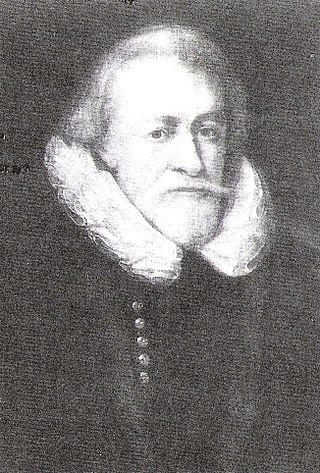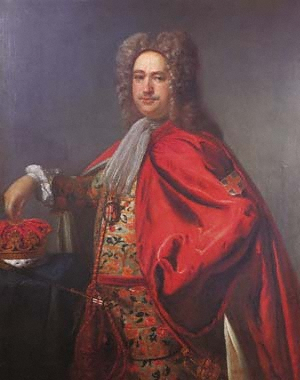Related Research Articles

The Church of St Benet Paul's Wharf is a Welsh Anglican church in the City of London, England. Since 1556, it has also been the official church of the College of Arms in which many officers of arms have been buried. In 1666 it was destroyed in the Great Fire of London, after which it was rebuilt and merged with nearby St Peter's. The current church was designed by Sir Christopher Wren. It is one of only four churches in the City of London to escape damage during World War II.

John Vesey or Veysey was Bishop of Exeter from 1519 until his death in 1554, having been briefly deposed 1551–3 by King Edward VI for his opposition to the Reformation.

Garter Principal King of Arms is the senior king of arms and officer of arms of the College of Arms, the heraldic authority with jurisdiction over England, Wales and Northern Ireland. The position has existed since 1415.

Sir Gilbert Dethick was a long-serving English officer of arms at the College of Arms in London. He would eventually rise to the highest heraldic office in England and serve as Garter Principal King of Arms.

Sir Thomas Woodcock FRHSC is a genealogist who served as Garter Principal King of Arms at the College of Arms from 2010 to 2021.
Robert Aldrich or Aldridge was Bishop of Carlisle in the reigns of Henry VIII, Edward VI and Mary.

Heraldic visitations were tours of inspection undertaken by Kings of Arms throughout England, Wales and Ireland. Their purpose was to register and regulate the coats of arms of nobility, gentry and boroughs, and to record pedigrees. They took place from 1530 to 1688, and their records provide important source material for historians and genealogists.

Sir William Dethick was a long-serving officer of arms at the College of Arms in London. He was the son of Sir Gilbert Dethick and followed his father as Garter Principal King of Arms. Though he was adjudged a qualified armorist and antiquarian, Dethick's biography is notable for numerous instances of conflict with his colleagues and others.
Sir Richard St George was a long-serving officer of arms at the College of Arms in London during the seventeenth century.
Charles Wriothesley was a long-serving officer of arms at the College of Arms in London. He was the last member of a dynasty of heralds that started with his grandfather—Garter Principal King of Arms John Writhe.

John Anstis was an English officer of arms, antiquarian and politician who sat in the House of Commons between 1702 and 1722. He rose to the highest heraldic office in England and became Garter King of Arms in 1718 after years of political manoeuvring.

Ralph Bigland was an English officer of arms, antiquarian and cheesemaker. He was born at Stepney, Middlesex, and was the only son of Richard Bigland and his wife, Mary. His father was a native of Westmorland, descended from the Bigland family of Biglands. He should not be confused with his nephew Sir Ralph Bigland, who also served as an officer of arms.

Roger Lupton was an English lawyer and cleric who served as chaplain to King Henry VII (1485–1509) and to his son King Henry VIII (1509–1547) and was appointed by the former as Provost of Eton College (1503/4–1535).

Sir William Segar was a portrait painter and officer of arms to the court of Elizabeth I of England; he became Garter King of Arms under James I.

English heraldry is the form of coats of arms and other heraldic bearings and insignia used in England. It lies within the so-called Gallo-British tradition. Coats of arms in England are regulated and granted to individuals by the English kings of arms of the College of Arms. An individual's arms may also be borne 'by courtesy' by members of the holder's nuclear family, subject to a system of cadency marks, to differentiate those displays from the arms of the original holder. The English heraldic style is exemplified in the arms of British royalty, and is reflected in the civic arms of cities and towns, as well as the noble arms of individuals in England. Royal orders in England, such as the Order of the Garter, also maintain notable heraldic bearings.

Ralph Brooke (1553–1625) was an English Officer of Arms in the reigns of Elizabeth I and James I. He is known for his critiques of the work of other members of the College of Arms, most particularly in A Discoverie of Certaine Errours Published in Print in the Much Commended 'Britannia' 1594, which touched off a feud with its author, the revered antiquarian and herald William Camden.
William Flower (1497/98–1588) was an English Officer of Arms in the reigns of Henry VIII, Edward VI, Mary I and Elizabeth I. He rose to the rank of Norroy King of Arms, serving in that capacity from 1562 until his death in 1588.

Robert Glover was an English officer of arms, genealogist and antiquarian in the reign of Elizabeth I. In the College of Arms, he rose to the rank of Somerset Herald of Arms, serving in that capacity from 1571 until his death in 1588. As marshal and deputy to his father-in-law, William Flower, Norroy King of Arms, he participated in heraldic visitations throughout northern England.

Robert Cooke was an English Officer of Arms during the reign of Elizabeth I, who rose swiftly through the ranks of the College of Arms to Clarenceux King of Arms, serving in that office from 1567 until his death in 1592–3.

The Shakespeare coat of arms is an English coat of arms. It was granted to John Shakespeare, a glover from Stratford-upon-Avon, Warwickshire, in 1596, and was used by his son, the playwright William Shakespeare, and other descendants.
References
- ↑ The history and antiquities of the city of Carlisle
- ↑ Dictionary of National Biography , Dethick, Sir Gilbert (1519?–1584), Garter king-of-arms, by Thompson Cooper. Published 1888.
- ↑ Alumni Oxonienses 1500–1714, Dabbe-Dirkin
- ↑ Horn, Joyce M.; Smith, David M.; Mussett, Patrick (2004), Fasti Ecclesiae Anglicanae 1541–1857, vol. 11, pp. 18–20
- ↑ "A History of the County of Durham, volume 2:Masters of Greatham Hospital". Britiah History Online. Retrieved 13 March 2024.